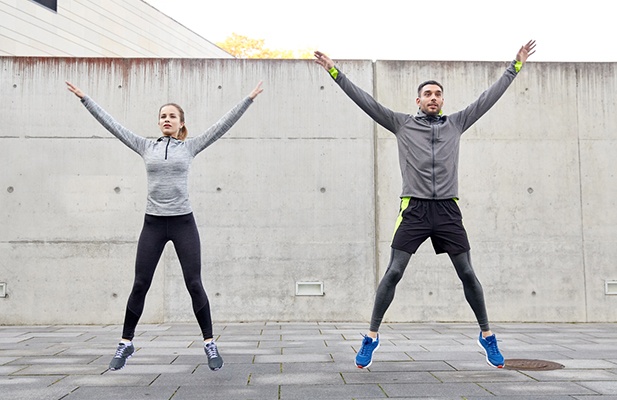
We've known for decades how important it is to warm up before running. A warm-up routine literally warms the body, increasing heart and respiration rates, taking oxygen to the muscles and tissues. Increasing the body temperature gently prepares muscles, tendons, and ligaments for exertion, easing the stress of transitioning from rest to work. Warming up improves performance and prevents injury.
The difference between static and dynamic stretching
People used to be advised to stretch before they run, and you will still often see people stretching their calves or hamstrings before a run. However, studies in recent years have shown that static stretching before exercise actually decreases performance.
A static stretch is the act of stretching a muscle and holding that position for several seconds. This action is great for increasing flexibility, but, done before exercise, it tires your muscles, and doesn't improve recovery or reduce risk of injury.
Dynamic stretching, on the other hand, moves a muscle smoothly through a full range of motion. Rather than holding a muscle in an extension, the muscle naturally extends and contracts with the motion of the stretch.
Why dynamic exercise is better before a run
Because dynamic stretches involve moving the muscles instead of holding them, they boost circulation and are more effective for warming up the body. Dynamic stretches are basically a low-intensity form of exercise, and don't strain joints, tendons, or muscles. Done before exercise, dynamic stretching is the best way to prepare the body for exertion and stress.
A good pre-run dynamic routine
While every runner has their own preferences, and it's good to alter your routine from time to time, here is a great series of dynamic stretches incorporate into your pre-run workout. They are easy to do anywhere, and don't require any equipment:
- Jumping jacks. Jumping jacks involve the whole body in a simple motion that boosts heart rate and circulation. Stand with your feet together and your hands at your sides. While quickly jumping your legs apart to the sides, raise your hands to meet over your head. Quickly jump your legs back together and drop your hands to your sides. Repeat for a couple minutes, or 50-100 times.
- Pillar Bridge. The pillar bridge, also known as the plank position, strengthens the core muscles and improves stability. Face down on the ground, as if you were doing a push-up, raise your upper body to rest on your elbows and lower body to rest on your toes, keeping the whole body in the air, resting on your elbows and toes. Hold the position, keeping the body flat by tightening the abdominal muscles. Hold for several seconds.
- Glute Bridge. The glute bridge strengthens the hips, lower back, and lower body. This is particularly important for runners, because weakness in the hips and lower back frequently cause pain and injury in the knees. Lie face up on the ground, with your knees bent and feet flat on the ground, arms at your side with the palms down. Lift your hips up off the ground, until your bodyweight is held up by the flat bottoms of your feet and the back of your shoulder blades on the ground, keeping your knees, hips, and shoulders in a straight line by tightening the gluteus muscles. Slowly lower the hips and then repeat the lift for a total of 10 times.
- High knees. High knees are also good for boosting circulation, building lower body strength, and reducing repetitive injuries from running. Mimic the body motion of running, hopping from foot to foot, and swinging the arms, but with every step, lift the knee as high as possible. Try to touch the knee to your elbow. Run gently in place with high knees for a couple minutes to warm the whole body.
- Squat jumps. Jump squats are another dynamic motion that warms the whole body quickly, as well as increasing flexibility and stability. Stand with both feet shoulder width apart, then bend the knees keeping the back straight until you are in a squat position, with your arms extended behind you. From the squat pose, jump quickly up in the air and raise the arms up over your head, then bring the arms down and bend the knees to land in the squat position. Repeat for a couple minutes for a full-body warm-up.









-1.png)